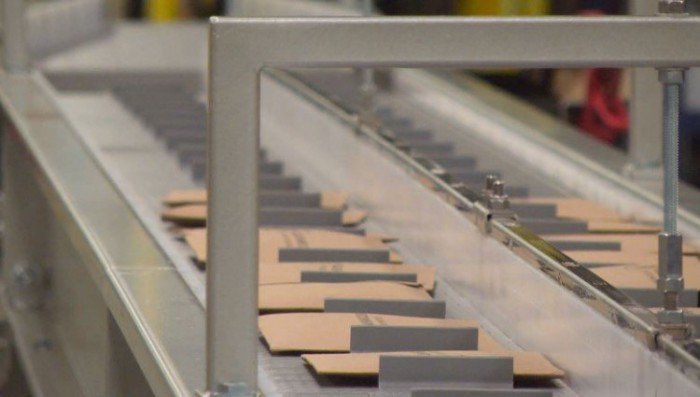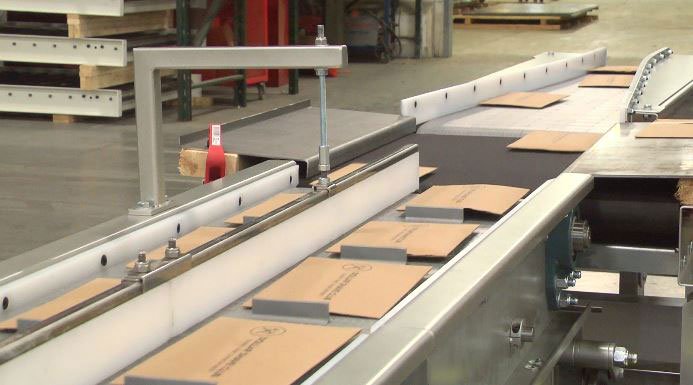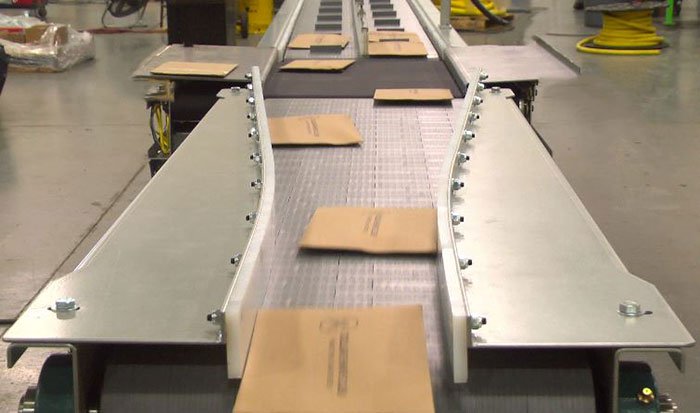
New Bastian Solutions Conveyor Product: Two-Lane Flighted Conveyor Merge
Matt Kohler | 23 March 2016
It’s a bird. It’s a plane. No, it’s a flighted conveyor merge. The Bastian Solutions Conveyor flighted conveyor merge may sound like some sort of fancy, new piece of technology that uses cutting-edge controls to parse products at lightning speed through the air. Well, it’s actually much simpler than that. In fact, it kind of removes the need for controls. And fancy technology. It’s really quite simple. A merge is a device used in a conveyor system to provide a means of combining two or more lanes of product into one lane. This process can be done a multitude of ways with varying levels of complexity, price, and footprint. No one type of merge is the superior option for all cases, and it often comes down to a limiting factor that drives the purchasing decision.
How It Works
The flighted conveyor merge is a fairly new type of merge in Bastian Automation Engineering’s arsenal of Bastian Solutions conveyor products. It operates in much the same way as many other merge types, from a high level of thinking. Product comes into the blackbox that is the merge in two adjacent lanes and exits in one lane with the product being tightly spaced, back-to-back.  The inner workings of the merge, however, are where the flighted conveyor merge gets its name. Product is placed on the AC driven, Intralox belt in between series of “flights” that are evenly spaced along the length of the conveyor. These flights, or tabs in essence, create distinct zones for each product. The zones are strategically staggered such that there is an offset from one parallel lane to the next. The first product reaches the end of the belt and is shuttled onto a belted gapper that pulls the product away by drawing a “gap” due to the speed variance. As the product moves along the length of the gapper, it is funneled toward the center of the belt by an angled guide rail, and in a short distance, the product is zippered and merged into one lane of back-to-back product.
The inner workings of the merge, however, are where the flighted conveyor merge gets its name. Product is placed on the AC driven, Intralox belt in between series of “flights” that are evenly spaced along the length of the conveyor. These flights, or tabs in essence, create distinct zones for each product. The zones are strategically staggered such that there is an offset from one parallel lane to the next. The first product reaches the end of the belt and is shuttled onto a belted gapper that pulls the product away by drawing a “gap” due to the speed variance. As the product moves along the length of the gapper, it is funneled toward the center of the belt by an angled guide rail, and in a short distance, the product is zippered and merged into one lane of back-to-back product. 
Flighted Conveyor Merge Benefits
As was stated before, the flighted conveyor merge is not the only merge on the market. So, why use it? Well, a flighted conveyor merge has many advantages. Since the belt is composed of inexpensive, modular pieces of hard plastic that interlock (Intralox) with one another, the belt can easily be made to fit the product being conveyed. This is also the disadvantage of a flighted conveyor merge, as the “zones” created by the flights MUST be large enough to support the longest product. If the variation in SKU lengths is great, throughput may be sacrificed for the low price of the belt and its functionality.  The belt is easy to maintain and requires no controls to release product at the infeed. That’s right, NO controls. Once the flighted conveyor merge has power and product to merge, it is fully operational, which means one less hurdle when you are trying to hit that impending system “go live” date. Not all merges are created equal, so it is helpful to know what options are available in order to find the one that suits your application best. Maybe the flighted conveyor merge will swoop in to save the day, or some time off your ROI.
The belt is easy to maintain and requires no controls to release product at the infeed. That’s right, NO controls. Once the flighted conveyor merge has power and product to merge, it is fully operational, which means one less hurdle when you are trying to hit that impending system “go live” date. Not all merges are created equal, so it is helpful to know what options are available in order to find the one that suits your application best. Maybe the flighted conveyor merge will swoop in to save the day, or some time off your ROI.
Matt Kohler, Bastian Solutions Director of Applications has been with Bastian Solutions since 2005, after receiving his degree in mechanical engineering from the University of Missouri - Columbia. The applications team at Bastian Solutions prides themselves on thoroughly understanding their customer’s unique needs and then tailors a solution that gives those customers a competitive edge in their business.
Comments
No comments have been posted to this Blog Post
Leave a Reply
Your email address will not be published.
Comment
Thank you for your comment.